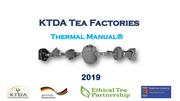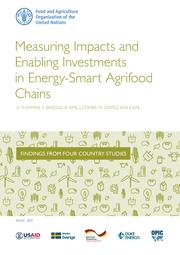Knowledge fuels change
For over a decade, Energypedia has shared free, reliable energy expertise with the world.
We’re now facing a serious funding gap.
Help keep this platform alive — your donation, big or small, truly matters!
Thank you for your support
Climate-Smart Agrifood Systems: Publications
From energypedia
Sustainable Energy for Food
- FAO and GIZ (2015). Opportunities for Agri-Food Chains to become Energy-Smart.
- World Business Council for Sustainable Development (2014). Co-optimizing Solutions: Water and Energy for Food, Feed and Fiber.
- GIZ (2016). Sustainable Energy for Food - Massive Open Online Course - Reader.
- IRENA (2016). Renewable Energy Benefits - Decentralised Solutions in Agri Food-Chains.
Water Use in Agriculture
- FAO. The World is Thirsty ...
- IGRAC (2019). Groundwater in a Changing World.
- FAO. Irrigation Management.
- Strzepek, K., & Boehlert, B. (2010). Competition for water for the food system. Philosophical transactions of the Royal Society of London. Series B, Biological sciences, 365(1554).
- David Molden and IWMI (2007). Water for Food, Water for Life. Earthscan.
- Gruère, G. and H. Le Boëdec (2019). Navigating pathways to reform water policies in agriculture. OECD Food, Agriculture and Fisheries Papers, No. 128, OECD Publishing, Paris.
- FAO and World Water Council (2015). Towards a Water and Food Secure Future – Critical Perspectives for Policy-Makers.
Application
Pumping and Irrigation
- Country Case Study Ongata-Rongai (Kenya): Hydroponics
- Country Case Study Chile – La Tirana
- Country Case Study India –Lalpura
- Country Case Study Holgojo Farm (Kenya)
- Country Case Study Alaoui (Morocco)
- IRENA (2016). Solar Pumping for Irrigation: Improving Livelihoods and Sustainability.
- FAO and GIZ (2018). The Benefits and Risks of Solar-Powered Irrigation: An Overview.
- GIZ (2019). Investigation de l’impact des installations de pompage solaire sur la consommation d’eau et la situation socio- économique d’un agriculteur dans 3 zones pilotes au Maroc.
- UNICEF (2019). Le Pompage Solaire. Appliqué aux Adductions d’Eau Potable en milieu rural. Manuel de Formation.
Cooling
- GIZ (2018). Implications of natural refrigerants for cooling technologies.
- REEEP (2017). Clean Energy Solutions for Milk Cooling in India and Kenya.
Drying
Other Type of Food Processing
Energy Source
Solar Power
- Solar Powered Irrigation Country Case Study Chile – La Tirana.
- Country Case Study India –Lalpura.
- Country Case Study Holgojo Farm (Kenya).
- Country Case Study Alaoui (Morocco).
- IRENA (2016). Solar Pumping for Irrigation: Improving Livelihoods and Sustainability.
- FAO and GIZ (2018). The Benefits and Risks of Solar-Powered Irrigation: An Overview.
- GIZ (2019). Investigation de l’impact des installations de pompage solaire sur la consommation d’eau et la situation socio- économique d’un agriculteur dans 3 zones pilotes au Maroc.
- UNICEF (2019). Le Pompage Solaire. Appliqué aux Adductions d’Eau Potable en milieu rural. Manuel de Formation.
Solar Powered Cooling
- Costs and Benefits of Clean-Energy-Technologies in the Milk Value Chain:
Solar Drying
- Solar Rice Dryer
- Coffee Processing with Solar Dryers in Peru
- Drying Peaches with Solar Dryers in Bolivia
Other Solar Powered Applications
Biomass / Biogas
- World Bank Group (2019). Have Improved Cookstoves Benefitted Rural Kenyans?
- Bioenergy for Agricultural Production.
Wind and Hydro Power
Value Chains
Dairy
- ICFN and FAO (2010). Pro-Poor Livestock Policy Initiative. Status and Prospects for Smallholder Milk Production: A Global Perspective.
- Costs and Benefits of Clean-Energy-Technologies in the Milk Value Chain:
Rice
- FAO (2015). The Rice Value Chain in Tanzania. A Report from the Southern Highlands Food Systems Programme.
- Winrock International (2012). Rice Value Chain Analysis – Sokoto State Nigeria.
- Nidagundi, A. and Mulimani, R. (2017). Design and Fabrication of Solar Paddy Threshing Machine for Agriculture Purpose. International Journal of Innovative and Emerging Research in Engineering, 4(10).
- FAO (2018). Costs and Benefits of Clean Energy Technologies in the Philippines' Rice Value Chain.
Fruit and Vegetables
- Solar-Powered Oil Press for Sesame Seed
- F. Joosten, Y. Dijkxhoorn, Y. Sertse and R.Ruben. How Does the Fruit and Vegetable Sector contribute to Food and Nutrition Security?
Tea
Energy Efficiency
- Energy Efficiency Potentials in the Kenyan Tea Sector – Reducing Energy Consumption at Tea Processing Factories: https://energypedia.info/images/0/05/Reducing_Energy_Consumption_at_Tea_Processing_Factories.pdf
Financing and Business Models
- REEEP and FAO (2014): Making the Case: How Agrifood Firms are Building New Business Cases in the Water-Energy-Food Nexus.
- INVESTA Project
- INVESTA Policy Briefs























